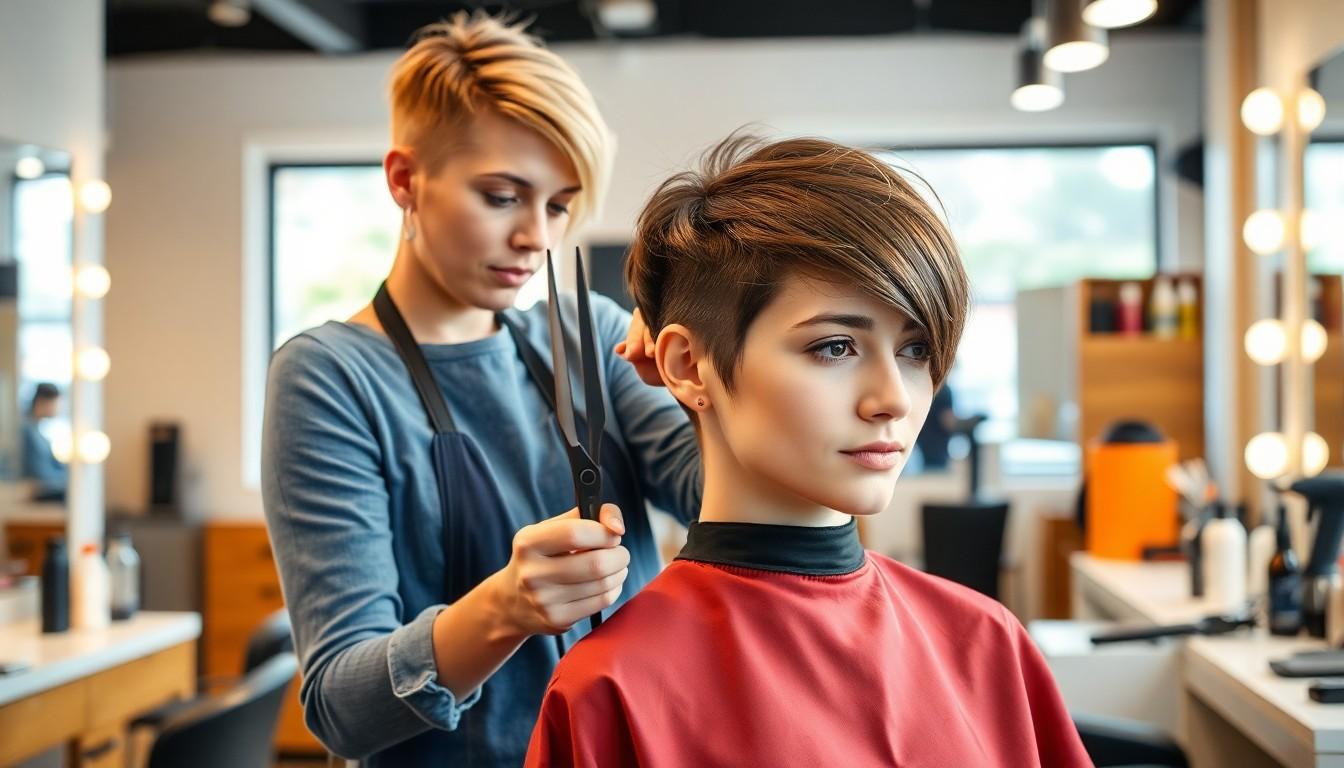Thinking about growing out that pixie cut but worried about the awkward in-between stage? We’ve all been there—eager for a new look but unsure how to make the transition smooth and stylish. The good news is we don’t have to settle for months of bad hair days or endless frustration.
With a few smart tips and a little patience we can turn this journey into a chance to experiment and have fun with our style. Let’s unlock the secrets to growing out a pixie cut with confidence so every stage feels fresh and fabulous.
Understanding the Pixie Cut Growth Process
Every journey to longer hair begins with patience and realistic expectations. Figuring out what to expect from the process can make us feel much more in control.
How Pixie Cut Hair Grows Over Time
Hair grows at an average of about half an inch every month, according to the American Academy of Dermatology. We’ll notice the back and sides usually fill in quickest, while layers on top often lag behind. Each new stage changes the shape of our style. Frequently, our nape gets longer before our crown evens out, making awkward phases hard to avoid. Regular trims can help keep ends healthy as new growth comes in, making the transition look intentional instead of unkempt.
Common Challenges When Growing Out a Pixie Cut
Awkward shapes and uneven lengths show up fast as our pixie grows. Suddenly, we’re dealing with unpredictable volume and extra flips around the ears or neckline. Styling can get tricky when stubborn cowlicks or bulky layers refuse to cooperate. Many of us feel tempted to chop it all off again when the process slows or thick pieces stick out. Finding answers like strategic parting, creative accessories or scheduling maintenance trims allows us to manage these stressful stages confidently.
Creating a Hair Care Routine for Growing Pixie Cut Short Hair

Growing out a pixie cut takes patience, and a solid hair care routine makes the process so much easier. We want our hair to look stylish at every stage, so keeping it healthy as it grows should be a top priority.
Choosing the Right Shampoo and Conditioner
We should always pick a shampoo and conditioner that match our hair type, whether our hair is fine, coarse, curly, or straight. Finding the right formulas lets us keep our locks strong and prevents dryness or oiliness as our hair gets longer. Products made for our exact hair needs help maintain a healthy scalp, which is important for steady growth.
Incorporating Regular Trims and Maintenance
Scheduling regular trims helps our pixie cut look intentional at every stage. Our stylist can shape the sides and back, making sure they stay neat while letting the top layers catch up. By asking for texturizing during appointments, we keep our hair from getting shaggy or bulky, which tames awkward lengths and helps the style transition smoothly. Breaking the journey into short-term goals, like aiming to even out our layers every eight weeks, keeps us motivated and our hair looking fresh.
Deep Conditioning for Healthy Growth
Using deep conditioning treatments protects our hair from breakage, especially if we use styling products or heat tools. We benefit from masks and treatments that hydrate the strands and nourish the scalp, supporting healthy hair from root to tip. Making deep conditioning a regular habit builds resilience and helps our hair look glossy and soft throughout the grow-out period.
Styling Tricks to Manage Awkward Pixie Cut Phases

Let’s be real—growing out a pixie cut challenges our patience and styling skills. Trying some small tweaks makes a huge difference when we hit that in-between stage.
Using Hair Accessories to Tame Unruly Layers
We all battle with layers that stick out or fall flat. Hair clips and headbands are our best friends here, keeping stray sections tidy and adding polish. On days when nothing goes right, tossing on a cute hat or wrapping a scarf around our head quickly hides uneven spots. Accessories don’t just keep hair in check—they bring personality and style to every look.
Experimenting With Texture and Volume Products
Dry shampoo or texturizing spray gives our hair a boost, lifting the roots and building instant volume even if strands sit awkwardly. Applying a little styling cream or pomade tames shorter flyaways and gives layers a defined shape without feeling stiff. Volume-improving products save the day when our hair feels limp or flat, helping us create styles that look intentional instead of accidental. Swapping and layering these go-to products lets us control texture and keep our new length looking chic every step of the way.
Embracing Hair Health for Faster Pixie Cut Growth

Supporting our pixie cut journey with the right hair health habits makes all the difference. We can speed up healthy growth by giving our hair the best foundation from within and outside.
Eating Nutrient-Rich Foods for Hair Growth
Let’s start by fueling our bodies right. Packing our meals with nutrient-dense foods helps our hair grow stronger and faster. Foods rich in vitamins A, C, and E, such as spinach, avocados, and sweet potatoes, nourish every strand. Including plenty of iron, zinc, and biotin, like what we find in lean meats, eggs, nuts, and legumes, boosts our scalp health and supports new hair growth. Prioritizing whole, colorful foods provides the essential building blocks for lush locks.
Avoiding Heat Damage and Over-Styling
Keeping heat tools in check goes a long way in maintaining healthy pixie regrowth. Limiting flat irons, curling wands, and hot blow dryers dramatically reduces breakage, since heat weakens hair and slows our progress. Embracing our hair’s natural texture protects each strand, so giving those tools a rest becomes the best move. Styling with less product and skipping daily heat leaves our hair shiny and resilient while growing out. Choosing gentle, damage-free techniques—like using a wide-tooth comb or air-drying—lets our hair shine in its healthiest form.
Consulting Professionals for Expert Pixie Cut Growth Advice

We all know growing out a pixie cut can be tricky, so getting expert help early makes a huge difference. Let’s talk about how pros can guide us through every stage with less stress and a lot more style.
Scheduling Salon Visits for Transitional Haircuts
Booking regular trims with our stylist helps keep everything neat, even as our hair changes length. Stylists focus on shaping the back and sides, stopping them from looking or feeling bulky while the top layers catch up. Even a tiny trim every six to eight weeks smooths out uneven growth and avoids the dreaded mullet effect. By sticking to a pro’s schedule, we get guidance on what looks best through each phase and keep our hair looking intentional—not messy or accidental.
Seeking Personalized Recommendations From Stylists
Asking for exact advice from our stylist tailors the grow-out process to our unique hair type, whether our texture is fine, curly, or somewhere in between. Many stylists recommend weekly conditioning treatments, coconut oil for the scalp, and targeted supplements to support stronger strands. They often show us quick styles and accessories, like headbands, that work with our natural hair rather than fighting it. Stylists know the best tools, products, and even scalp massage techniques that boost our growth journey and keep our scalp healthy. When we trust their experience, our transition feels smoother and our hair gets exactly what it needs every step of the way.
Adopting Patience and Confidence During the Pixie Cut Growth Journey

Embracing the process makes a huge difference when we’re dealing with the ups and downs of growing out a pixie cut. Sometimes it feels like the awkward stages last forever, but focusing on progress and building confidence really helps.
Celebrating Small Milestones and Progress
We break down our long-term hair goals into smaller, realistic milestones to keep motivation high. Setting sights on reaching jaw-length first—rather than thinking of a full bob or lob—lets us see tangible progress. Visiting our stylist every eight weeks just for a trim on the back or a little texturizing makes a lopsided shape feel like a phase worth celebrating. We like to take photos along the way, pinning up our favorites as reminders of how far we’ve already come.
Building Confidence With Each Stage
At each new length, we switch things up to find what looks best for us. Sharing our goals with our hairstylist—using pictures and honest conversations—allows us to feel supported and understood. Experimenting with side parts, playful clips, or a bit of texture spray turns each awkward phase into a chance to try something different. Some days, simply looking at a goal hairstyle photo on our mirror reminds us why patience pays off. We celebrate every successful hair day as proof that we’re rocking this grow-out journey, one stage at a time.
Conclusion
Growing out a pixie cut is a unique experience that tests our patience and creativity. Every stage brings its own set of challenges and opportunities to try something new with our look.
Let’s remember that each step forward is progress worth celebrating. With the right mindset and a bit of experimentation we can transform the grow-out process into a rewarding journey that’s all our own.
Frequently Asked Questions
How long does it take to grow out a pixie cut?
On average, hair grows about half an inch per month. Depending on your goal length and hair type, it can take anywhere from several months to over a year to fully grow out a pixie cut.
What are the most common challenges when growing out a pixie cut?
The biggest challenges include uneven growth, awkward shapes, extra volume at the back and sides, and stubborn cowlicks. These issues can make hair feel difficult to style during the transition.
How can I manage the “awkward stage” while growing out my pixie cut?
Stay proactive with regular trims to keep the shape neat and intentional. Use hair accessories, experiment with parting, and try texturizing products to manage volume and layers during this period.
How often should I trim my hair while growing out a pixie cut?
Trim your hair every 6–8 weeks. Regular trims help maintain shape, remove split ends, and prevent your hair from looking messy as it grows.
What products should I use while growing out my pixie cut?
Choose a shampoo and conditioner suited for your hair type, use deep conditioning treatments for strength, and add styling products such as dry shampoo and texturizing spray to manage volume and layers.
Are there styling tips for dealing with unruly or uneven hair during this process?
Yes—try clips, headbands, scarves, or hats to tame problematic sections. Styling products like mousse or texturizing spray can also help create intentional looks, making uneven areas blend more easily.
How can I encourage healthy hair growth during this time?
Adopt a balanced diet rich in vitamins and minerals, such as leafy greens, avocados, and lean meats. Minimize heat styling to prevent breakage and use gentle, nourishing hair products.
Should I see a stylist while growing out my pixie cut?
Absolutely. Regular salon visits ensure your hair grows out neatly. Stylists can offer personalized trims and suggest products or treatments to support healthy growth and ease the transition.
How can I stay motivated and positive during the grow-out process?
Set realistic expectations and celebrate small milestones, like reaching new lengths. Take photos to track progress, try out new styles, and remember that patience and confidence will help you enjoy the journey.







